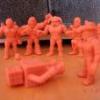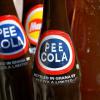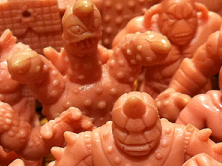I think you're not really understanding what I'm saying. As "super rare" as these figures are, no retailer offered these up for sale at their store asawk. If they were included in regular packaging, neither the retailer nor the customer would have any clue and the price would remain the same. Since no special advertising was done (Kaybee Toys the exception?? I want to see those ads), where is the draw?
Premiums and Incentive figures are different from Exclusives. Exclusives are a newer idea formed specifically for certain retailers on a mass scale (i.e. Wal-Mart's Jabba the Hutt figure). Exclusives are still abundant, but you can only buy them at a certain store. Incentive figures are designed specifically to make retailers buy more product, with no specific retailer in mind.
So basically the scenario you are describing is this: Toys 'r Us has to order 100 24-packs to get that super duper rare one off figure. So they spent all that money to get one lousy figure. Did that one figure get its own special packaging and retail for a higher price? Did it get included in regular packaging? Was it loose and meant only for the retailer as a collector's item? In all three scenarios I see no benefit to the retailer. I see that they lose lots of money on over-ordering product that probably won't sell because of peg warming, and second they have one special little figure they can't advertise, sell, or do anything with.
Doesn't make sense.
I don't think you understand us, Johnnie Cochran. It
DOES make sense. MUSCLEs were cancelled in North America barely after they were released. That's why more advertising dollars were never wasted on promoting the chance at finding a super rare figure.
Joe Morrison stated the super rare figures were given only to retailers who placed large enough orders. Whether this means Toysrus was given one super rare in its case assortments exclusive only to Toyrsus and Kaybee toys was given another super rare exclusive only to it, or if all big retailers received super rares mixed in with, say, each pallet of MUSCLEs they ordered, we don't know for sure. But that doesn't really matter. If Toysrus received one super rare and Kaybee a different super rare, they each would have advertised the opportunity to find a special figure only at their stores. If all big retailers received premium super rare(s) in every pallet of cases they ordered, they would have advertised slightly more generically the opportunity to find various super rares. But this advertising never happened because of the precipitous and abrupt decline of the MUSCLE line. RETAILERS NEVER HAD AN OPPORTUNITY TO ADVERTISE SUPER RARES BECAUSE THE MUSCLE LINE ENDED SO QUICKLY. That's why they didn't bother wasting money advertising a dead line more than they already had.
PS Exclusives for specific retailers are most certainly not a new marketing tool. The Hit & Run GI Joe in 1988 was released in a special version at Target stores only.
http://www.yojoe.com...runtarget.shtmlEven before that, an exclusive Missile Command Headquarters was released as a Sears Exclusive in 1982.
http://www.yojoe.com...les/82/cobrahq/ Then again, in 1988 and 1989, the GI Joe Night Force line was released exclusive to Toysrus.
So, no, "store exclusives" are not new.
Edited by CuttleFishforsale, 26 July 2011 - 02:34 PM.
























